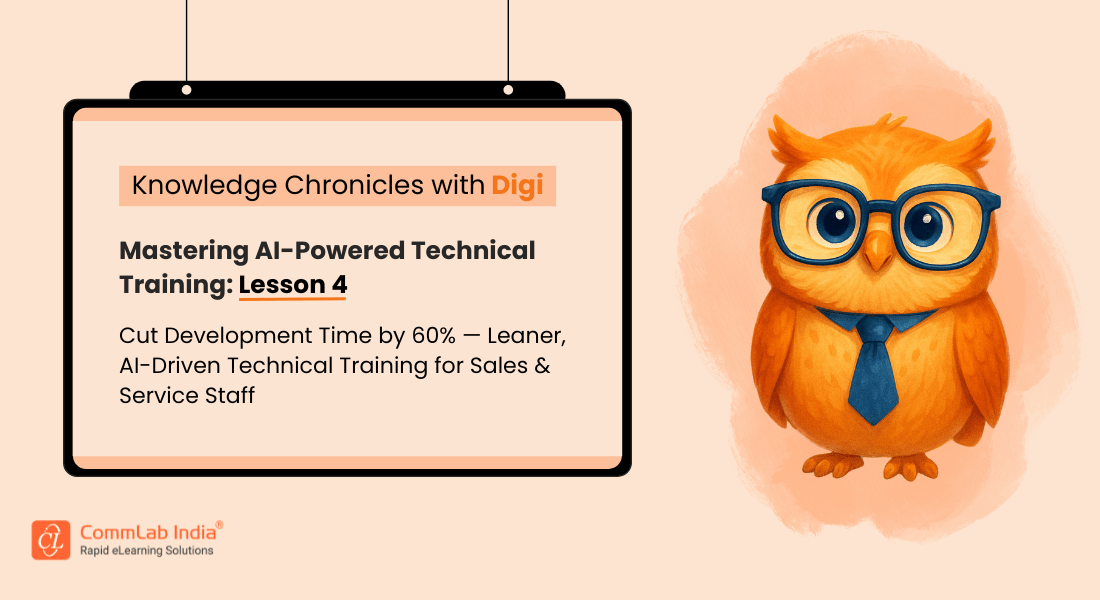How to Cut Course Timelines in Half with AI-Powered Technical Training

If you're still developing technical training the old way—manually scripting, animating, reviewing, and revising—then you're already behind. In today's high-velocity business world, especially in sectors where sales and service teams need to support rapid product releases, traditional training timelines are not just inefficient—they're a liability.
→ Download eBook: AI-Powered Technical Training
But there’s good news: with AI-powered workflows, it’s possible to cut development time by up to 60% without sacrificing quality. In fact, many organizations are finding that training speed and effectiveness can go hand-in-hand when learning development becomes lean, modular, and AI-accelerated. Here’s how it works.
Table Of Content
- Where Traditional Training Development Wastes Time
- The Lean, AI-Powered Workflow
- The 60% Time-Savings in Action
- Real-World Example: Electronics Retailer
- Pitfalls to Avoid
- A New Role for L&D
Where Traditional Training Development Wastes Time
Most L&D teams know the pain:
- Weeks of SME back-and-forth
- Script drafts and reviews
- Voiceover recordings and re-recordings
- Graphic design delays
- Localization timelines that stretch for months
This waterfall approach often takes 8–12 weeks per module—by which time the product or service has already evolved.

The Lean, AI-Powered Workflow
60% Faster Content with AI-Powered Technical Training Workflows
Here’s a five-step agile process:
- Capture SME Input in One Session
- Use AI to Draft Scripts and Assessments
- Prototype Rapidly with Multimedia Tools
- Review Through Visuals, Not Docs
- Launch and Localize Simultaneously
To slash development time, leading teams are adopting an agile five-step process supported by AI:
Step 1: Capture SME Input in One Session
Instead of multiple interviews and document exchanges, schedule one 60-minute recorded call. Use tools like Fireflies or Zoom to transcribe the session automatically. Then feed the transcript into ChatGPT to extract:
- Task sequences
- Learning objectives
- Script frameworks
- Scenario ideas
Step 2: Use AI to Draft Scripts and Assessments
With a solid transcript, you can prompt AI tools to generate:
- Microlearning scripts tailored to sales or service personas
- Scenario-based questions
- Summary sheets and Quick Reference Guides (QRGs)
This saves days—if not weeks—of manual writing.
Step 3: Prototype Rapidly with Multimedia Tools
AI Tools like Vyond or Synthesia allow IDs to quickly turn scripts into animated explainers or avatar-led modules. Add auto-generated voiceovers using ElevenLabs or Murf, and you have a functional prototype in hours.
Step 4: Review Through Visuals, Not Docs
Instead of sending static slides or Word docs, let SMEs review a clickable or playable prototype. They give more accurate feedback when they can see how it will appear to learners.
Step 5: Launch and Localize Simultaneously
Use Smartcat or DeepL to instantly translate drafts, QRGs, and even video captions. This enables near-parallel rollouts across global regions.
Discover how AI is transforming eLearning translations and making global learning more accessible than ever!
The 60% Time-Savings in Action
This lean model typically reduces each phase by:
- SME time: -70%
- Script creation: -60%
- Multimedia production: -80%
- Localization: -90%
When combined, your 8-week course becomes a 2.5-week launch. And with modular learning objects, you can reuse components across roles, products, or geographies.
Real-World Example: Electronics Retailer
A consumer electronics company needed to train its retail sales teams across 6 countries on a new smart home system. The product was launching in 30 days.
Using the AI-accelerated model, they:
- Recorded a single session with two product engineers
- Used ChatGPT to write scripts for 6 microlearning videos
- Built all modules in Vyond with automated voiceover
- Translated and localized using Smartcat
- Published on mobile LMS and embedded QR links in physical store displays
Results:
- Technical training was live 5 days before product launch
- 92% of retail associates completed it in the first week
- Post-launch customer issue calls dropped 40%
Pitfalls to Avoid
Cutting development time doesn’t mean cutting corners. Watch out for:
- Over-reliance on AI for accuracy: Always validate technical content with an SME.
- Lack of feedback loops: Get quick reviews early to prevent major rework.
- Skipping reinforcement: Even fast training needs follow-up to reinforce behaviors.
A New Role for L&D
This speed shift changes the L&D team's value proposition:
- From "content builders" to "workflow architects"
- From "order takers" to "performance partners"
- From "training developers" to "enablement strategists"
Final Thought
AI isn’t just a tool—it’s an accelerator. For L&D teams tasked with supporting sales and service performance, reducing development time isn’t optional. It’s your ticket to relevance.
With the right mix of AI tools and lean workflows, technical training can keep pace with product cycles, regional needs, and customer expectations—without overloading your SMEs or burning out your team.
The future of technical training is faster, leaner, and more impactful. And it starts by redesigning how we build.
Are you ready to launch in weeks, not months?






![Tips to Maximize Training ROI with Microlearning [Infographic]](https://blog.commlabindia.com/hubfs/blogs/tips-maximize-training-roi-microlearning-info.jpg)